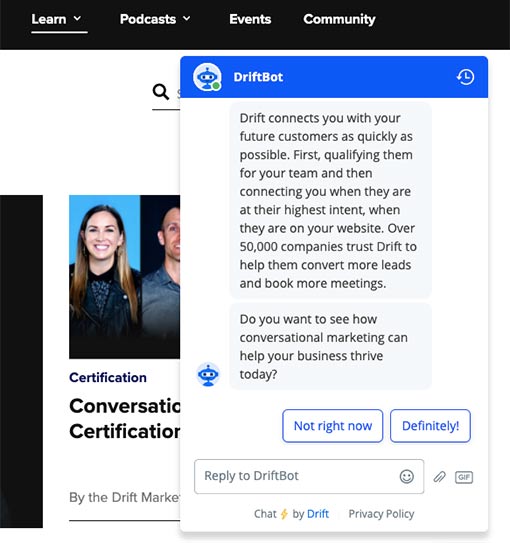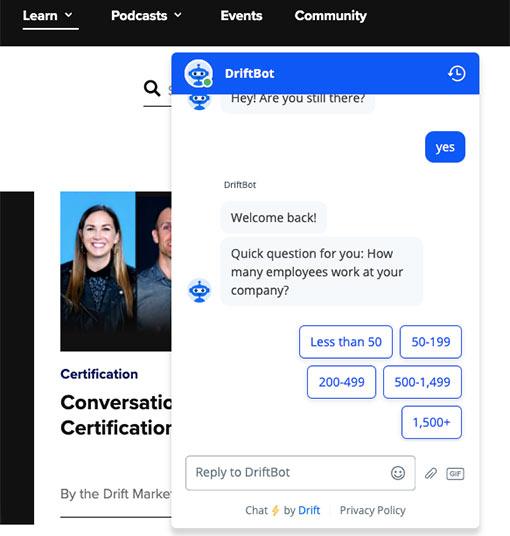Ben Goodey of SentiSum shares customer service improvement ideas you can use to drive return on investment (ROI).
Building a customer service experience that inspires joy, loyalty, and word of mouth buzz is not easy.
In this article are some project ideas that you can take on if you’d like to do just that.
But, before we dive in, let’s consider why customer service is so important to the business—and is certainly worthy of investment in projects like this.
Customer Service Is the Main Contributor to Business Growth
And I’m not exaggerating.
Excellent customer service drives retention, repeat purchase, basket size, and referrals.
Not only is customer retention cheaper than customer acquisition, but existing customers spend more and refer more.
Existing customers are 60-70% more likely to buy more of what you sell.
Furthermore, research by Fred Reichheld shows that a low 5% increase in customer retention leads to an increase of 25-95% in profits.
Isn’t it starting to sound absurd that companies focus so heavily on acquisition?
Here’s why we should focus on customer service retention:
- If your customer trusts you and has a great experience with your product, they’ll end up buying more products/services from you. It’s easier for them to buy more of your products and services due to switching costs—rebuilding trust, taking a risk on quality, etc
- If they are already in love with your business, they will refer their friends and acquaintances to you (more customers for your business).
As a marketer, I notice this reality every day.
For example, imagine that I hire an agency to develop a new website for us.
Their output (the product) is ultimately extremely important to me.
But, equally important is that the work is on time, the communication is clear, and my expectations are set well.
Those elements are the quality of their customer service and are where the trust is built.
Hit both points and I’ll purchase from the agency again. Perhaps even purchase some of their other products.
And, when asked, guess who I’ll refer from friends?
The cycle continues and this agency can run an efficient, low acquisition-cost business that runs on referrals.
Indeed, word of mouth is the most valuable customer acquisition channel.
Fred Reichheld also conducted an extensive eCommerce study and found that:
- Every eCommerce customer referred a minimum of three new customers after their first purchase
- After 10 purchases, the same person referred an average of 10 customers to the retailer
To clarify: customers refer other customers. Returning (i.e. happy) customers refer even more customers. The longer they return, the better this virtuous cycle becomes.
Because customer service is a direct influence on a customer’s experience, it deserves much more attention.
It’s important that customer service teams know their importance to a business. You deserve more investment, authority and acknowledgement.
Team’s that know their strategic importance are also less likely to experience customer service burnout.
I could even give you 100 examples about how a great customer service can skyrocket your business (we also wrote an eBook that explains how to sell the value of customer service internally).
But, you’re likely here to get customer service improvement ideas. So, here are eight that will help you improve customer satisfaction, agent experience, and business growth.
8 Unique Value-Driving Customer Service Improvement Ideas
1. Implement Support Ticket Tagging Automation Using AI
Every customer service department must have a grip on the problems facing its customers.
However, we live in a dynamic world and the problems faced by your customers yesterday are likely different from the ones they’ve been facing today.
When you see a spike in a new issue, you’ll know what’s driving it perhaps intuitively and anecdotally.
However, to make other departments take action against the new issue you’ll likely face the objection “show me the numbers”.
They want evidence so they know whether to prioritize your issue or not.
To get support ticket insights, you can manually analyse all your customer service channels and consolidate them under one roof.
But it’s frustratingly time-consuming and manual ticket tagging leaves room for human error and discrepancies.
If you use multiple people on your team to tag tickets, it becomes ever harder to train agents to understand tickets and tag them in a uniform way.
This is where support ticket analytics swaggers into the room.
SentiSum users can log in to the platform and digest the largest drivers of customer contact
You can filter for which day, week or month you want to look at. Even filter for today to get quick insights to help prevent current issues from troubling future customers.
British Airways initially used manual tagging to collect and manage customer queries across all their conversation channels. They created separate categories for each type of complaint and directed their analysts to list it under those categories.
But each analyst had a different thought process. Complaints, queries and surveys were tagged under different segments by each analyst, and it took them months sometimes to do reporting.
Using SentiSum’s AI-powered ticket tagging platform, British Airways consolidated and tracked the topic and sentiment of every email, chat, review and survey in real-time.
The AI solution automatically tagged all qualitative text under different segments and subsegments, the “rising topics” were then distributed every day to other department leads.
For those looking for a customer service improvement project, bringing clarity on customer pain points to the customer service team (and, therefore, every other team) is the highest impact possible.
It gives you absolute clarity on your customer, which is important for tackling churn, improving customer experience, and training your team on the latest issues. Your customer will thank you for getting ahead of their issues, and your team will be more than happy to have less manual tagging work.
2. Expand Your Customer Service Channels
The internet has increased the number made of channels your customer can contact you on.
In recent months we’ve even seen an explosion in the adoption of WhatsApp (800% increase in customer support through WhatsApp according to Zendesk), causing everyone to ponder whether WhatsApp will be the future of customer service.
As Facebook Inc expands its growth further in the customer service arena, we will increasingly see Instagram, Facebook and WhatsApp grow in use by customers.
Luckily, helpdesks like Zendesk centralize every channel. However, there’s still a nuance to each channel that shouldn’t be ignored.
Ask yourself where your customers are and where they most want to contact you.
If you’re extremely active on Instagram, it may be worth integrating Instagram into your helpdesk to receive messages.
If your customers leave lots of Trustpilot reviews, it might be sensible to create a closed-loop feedback strategy in which negative reviews are turned into helpdesk tickets which can be addressed by your team—never leaving unhappy customers unmanaged.
It can become complex to make sense of customer contact channels, which is why centralization is essential. This goes for analytics, too.
We’ve recently launched a new feature that automatically notes negative reviews left in social media comments and on review websites. The sentiment analysis detects the negative review and triggers it to become a support ticket that your team can pick up.
3. Kick Off Revenue-Driving Projects
Support-driven growth is easily the future of customer service.
We’ve seen a number of companies use customer service to:
- Train agents for roles like sales and product management (the deep customer understanding lends itself well)
- Nurture those mid buying an item into a sale (even increasing basket size)
- Increase profits by prioritizing customers on the precipice of churn (AI tools understand which customers are most frustrated, or have a challenge that historically led to churn, and push them to the front of the queue)
Pick one of these, or the numerous other ways to drive growth from the contact centre, and have a go at implementing them!
4. Implement a Website-Based Chatbot System
Okay, we aren’t bring something totally innovative to the conversation here…but if you don’t have a live chat with a degree of automation, you need to experiment with it.
If you are browsing a business website, you are likely there for one of three reasons:
- To learn more about the business and how they can help you
- To learn from their blog posts and resources
- To contact someone from their team
If you are on a website for the first and the third reason, a live chat would be a great aggregator in helping you solve your problems.
Here’s an example.
Let’s say that I want to invest in chatbot marketing for SentiSum. So I visit their website to learn more about their product.
As soon as I visit their website, a chatbot pops up, like so:


As my sole aim is to learn more about their offerings, I click on ” yes, please!”
As soon as I hit that button I get a message explaining how the chatbot can be used to improve my business. Now I am hooked to it and I click on “Definitely!”
Now the chatbot automatically starts collecting data about me and my organization. This takes me down a ladder of “yeses” until they finally have all the data about me.
It is set up for businesses talking to businesses—where the primary goal tends to be “lead generation”.
However, I want you to imagine a situation where you develop a chatbot specifically for your “help” and “FAQs” pages.
You can customize the chatbots to ask your visitors what they need help with. You can then guide them towards self-service resources you have put together on your website.
If needed you can also enable an option to directly connect them to a customer service agent.
Maybe you can take inspiration from a food retailer and create your own chatbot that automatically talks with your website visitors.
Apart from providing a great customer service, a chatbot can improve the overall user experience on your website.
All the key providers (e.g. Intercom, Zendesk, FreshDesk) allow you to set up intelligent chat automation.
We recommend only automating the very basics, however. Over-automation is often a pain for customers who just want to talk to their customers.
Get a feel for what makes good automation by browsing your favourite providers. It becomes quite easy to see what’s a pain for customers.
The presence of a chatbot is typically expected by customers and increases their trust and pushes them to complete the transaction. Pre-purchase, a chatbot offers your customer a quick way to clear any doubts they might have about your products and services. When all their objections and queries are cleared, they are ready to buy instantaneously.
5. Train Your Customer Service Representatives to Be More Empathetic
Empathy is a game changer for customer service improvement.
It’s a skill every agent needs to develop and as their leader, you can significantly improve customer satisfaction by coaching your team how to develop empathy.
As more and more automation technology is brought into the contact centre software stack, agents will spend more time building relationships with customers and less on repetitive admin.
In the future of customer service, empathy skills will dramatically increase in importance and investing in empathy skills is a customer service improvement idea that will also help your agents for the rest of their life.
6. Train Your Team to Address Your Customers by Their Name
This is one of the most underrated tips in customer service.
Training your agents to address customers by their name (to a reasonable extent, not in every sentence like a crazy person) goes a long way to making them feel special.
In research by Agilone, results showed that more than 70% of consumers expect personalization from their customer service experience.
We humans are hardwired to engage deeply when we hear our name. So, training your agents to address customers by their name makes it an innately personal experience.
Here’s what you tell your customer service agents:
- Ask for your customer’s name up front.
- If you’re on the phone, always start the conversation by greeting them with their name.
- If you’re on a text platform, yet again start with their name.
- If you’re on email, include their name on every email that you send out.
Whatever the channel might be, the rules are always the same. Include your customer’s name wherever relevant and needed.
7. Create a Knowledge Base or a Self-Service Hub
Creating a knowledge base shows your customers you care and reduces support ticket volume.
A knowledge base is a collection of resources about your product/services. Providing the right details at the right time is part of a great customer experience. Knowledge bases allow your customers to access the right information to solve their own problems and queries.
As a customer service improvement idea, a knowledge base allows your customers to problem solve without needing to contact your support team.
The option should always be there to talk to a real person, but sometimes people just want quick access to an answer.
For you, a knowledge base works particularly well because they reduce the effort your team puts in to those frequent queries.
Analyse your support tickets to work out what those easy-to-answer, repetitive questions are and write a short article to address the problem. Your customer service team can simply link the article to the customer or invest in an AI tool to auto-serve customers with articles.
8. Tackle Data Silos by Automating Distribution of Support Ticket Insights
Isn’t it annoying when you know what issue is driving high ticket volumes but have no power to tackle it yourself?
For you, it’s a no brainer. You’re informed and your KPIs are something like contacts per order.
Well, those in charge of change (the founder, product lead, ops lead, etc) need to be convinced to make the change, too.
To overcome this problem, try creating daily emails that show the biggest changes and the biggest drivers of tickets.
By doing so, you can better familiarize your business leaders with the value of the data that your contact centre collects.
After all, few understand the power of how much data is held in customer service departments.
It can literally set the strategy for customer-centric change across everything from production to marketing and sales.
We get really excited by this point because with simple changes we can reposition customer service as a strategic leader for any business.
That leads us nicely into our last point.
Bringing It All Together
A high-quality customer service is essential if you want to develop a high-growth, high-retention business.
No one starts out perfect, so we hope these customer service improvement ideas will help you come up with new ideas for your business that push it forward.
Remember, you’re only improving customer service if it benefits the customer. Otherwise, you’re just being more “cost efficient”.
That’s the old way of thinking.
Author: Guest Author
Published On: 6th Apr 2021 - Last modified: 7th May 2021
Read more about - Archived Content, SentiSum







